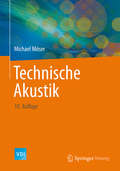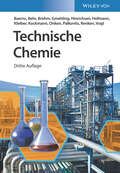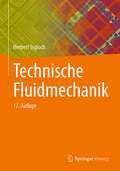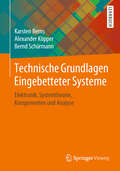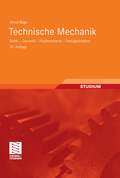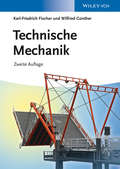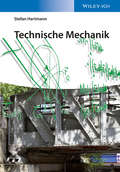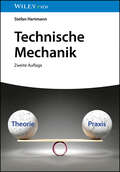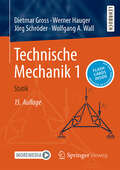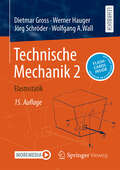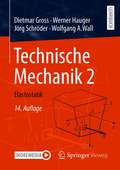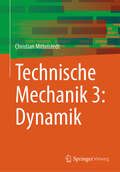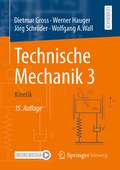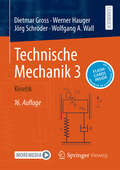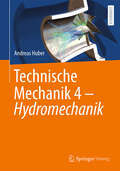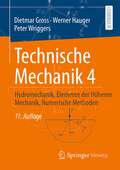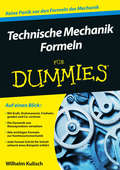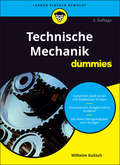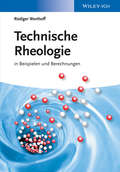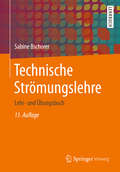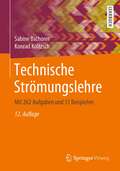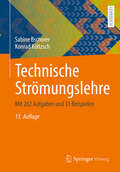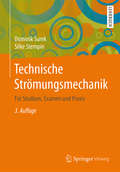- Table View
- List View
Technische Akustik
by Michael MöserDas Standardwerk der Akustik ist auf die Ingenieursausbildung zugeschnitten. In allen Kapiteln steht die Frage im Mittelpunkt, wie die Lautstärke in den wichtigsten Umgebungen (in Gebäuden und im Freien) verringert werden kann. Begleitend wird das notwendige Grundlagenwissen über die Natur von Schall und Schwingungen vermittelt. Für die Neuauflage wurden schalltechnische Normen aktualisiert, die Themen Wellenausbreitung sowie Schallschutzwände erfahren besondere Aufmerksamkeit. Mit Zusammenfassungen, Übungsaufgaben und Lösungen zu jedem Kapitel.
Technische Chemie
by Norbert Kockmann Albert Renken Arno Behr Jürgen Gmehling Michael Kleiber Manfred Baerns Axel Brehm Kai-Olaf Hinrichsen Hanns Hofmann Ulfert Onken Regina Palkovits Dieter VogtDas grundlegende Lehrbuch der Technischen Chemie mit hohem Praxisbezug in der dritten Auflage: * beschreibt didaktisch äußerst gelungen die Bereiche - chemische Reaktionstechnik, Grundoperationen, Verfahrensentwicklung sowie chemische Prozesse * alle Kapitel wurden komplett überarbeitet und aktualisiert * zahlreiche Fragen als Zusatzmaterial für Studenten online auf Wiley-VCH erhältlich * unterstützt das Lernen durch zahlreiche im Text eingestreute Rechenbeispiele, inklusive Lösung * setzt neben einem grundlegenden chemischen Verständnis und Grundkenntnissen der Physikalischen Chemie und Mathematik kein Spezialwissen voraus *NEU: Neue Technologien und Rohstoffe relevant für moderne industrielle Prozesse Ideal für Studierende der Chemie, des Chemieingenieurwesens und der Verfahrenstechnik in Bachelor- und Masterstudiengängen.
Technische Fluidmechanik
by Herbert SiglochDieses erfolgreiche Lehrbuch vermittelt die Grundlagen der Fluidmechanik und deren praxisbezogene Anwendung, geht jedoch über eine Einführung hinaus. Die strömungstechnischen Phänomene werden beschrieben und mathematisch exakt oder - falls dies nicht möglich - näherungsweise dargestellt. Sie werden durch Messwerte unterstützt und weitgehend physikalisch begründet. Zum besseren Verständnis sind die Erscheinungen der Fluidmechanik ausgehend von der Festkörpermechanik veranschaulicht. Dabei werden Analogien zu anderen Fachgebieten aufgezeigt. Dargestellt sind die Statik und Dynamik sowohl der Flüssigkeiten als auch der Gase und Dämpfe. Bei der Gasdynamik sind Unterschall- und Überschallströmungen einbezogen. Eine Einführung in die moderne numerische Strömungsmechanik - die Computational Fluid Dynamics (CFD) - ergänzt den Stoff. Hinzu kommen 100 Übungsbeispiele mit kompletten Lösungen. Der Anhang enthält technisch wichtige Tabellen sowie Diagramme für Stoffgrößen und Beiwerte der Strömungstechnik.In der 11. Auflage wurden Inhalte überarbeitet und das Werk wurde in ein neues Layout überführt.
Technische Grundlagen Eingebetteter Systeme: Elektronik, Systemtheorie, Komponenten und Analyse
by Karsten Berns Alexander Köpper Bernd SchürmannLernen Sie mit diesem Lehrbuch eingebettete Systeme besser kennenEmbedded Systems (eingebettete Systeme) sind aus dem Alltag nicht mehr wegzudenken. In Smartphones, Fahrzeugen oder Haushaltsgeräten verbinden sie die analoge mit der digitalen Welt. Daraus ergeben sich speziell für Entwickler eingebetteter Systeme viele Anforderungen. Sie müssen nicht nur Kenntnisse aus der Entwicklung von Softwaresystemen mitbringen, sondern gleichzeitig Wissen in Sachen Elektrotechnik oder Systemkomponenten besitzen. Dieses Lehrbuch führt Sie umfassend in das Feld eingebetteter Systeme ein. Die Autoren liefern Ihnen das notwendige methodische sowie systematische Wissen zur Systementwicklung. Zum optimalen Verständnis ist dieses Werk in vier Teile untergliedert:Technische Grundlagen eingebetteter Systeme aus den Gebieten Elektronik, Systemtheorie, Steuerung und Regelung Systemtheoretische Grundlagen und Entwürfe von ReglernÜberblick und Einbindung der Systemkomponenten eingebetteter SystemeModellierung und Analyse von Algorithmen mit Blick auf EchtzeitanforderungenDurch Anwendungsbeispiele und Methoden der Echtzeitplanung können Sie mit diesem Lehrbuch Ihr Wissen im Bereich eingebettete Systeme nachhaltig vertiefen. Inhaltlich für Praktiker und Theoretiker zu empfehlenAufgrund seines thematischen Schwerpunkts profitieren von diesem Werk speziell folgende Leser:a) Studierende und Anwender der Informatik ohne tiefgreifende Vorkenntnisse im Bereich Elektrotechnikb) Ingenieure, Physiker und Mathematiker, die sich für die Grundlagen der Entwicklung eingebetteter Systeme interessierenIn den einführenden Kapiteln des Lehrbuchs definieren die Autoren zunächst die Merkmale eingebetteter Systeme. Sie zeigen Ihnen Anwendungsfelder und erläutern, in welcher Form diese Systeme zum Einsatz kommen – beispielsweise als Cyber-Physikalische Systeme (CPS). Im weiteren Verlauf werden u. a. diese Teilaspekte näher behandelt:Elektrische NetzwerkeElektronische GrundschaltungenSignalverarbeitungsprozesseSensordatenverarbeitungAktuatorikRecheneinheiten für eingebettete SystemeKommunikationEin Grundlagenwerk mit verständlichem KonzeptDurch seinen systematischen Aufbau ermöglicht Ihnen dieses Werk einen schnellen Einstieg in die Materie. Anschauliche Tabellen, Grafiken, Anwendungsbeispiele sowie Modelle unterstützen Sie beim Lernprozess. Wenn Sie sich für eingebettete Systeme interessieren, darf dieses Lehrbuch in Ihrer Sammlung nicht fehlen.
Technische Mechanik
by Wolfgang Weißbach Alfred Böge Gert Böge Walter Schlemmer Wolfgang BögeSeit vielen Jahren ist der Böge das Standardlehrwerk für die Technische Mechanik an den Technikerschulen. Gründe dafür sind die systematische, klare und leicht zugängliche Darstellung des Stoffes in Text und Bild und die durch ausführliche Beispiele, Arbeitspläne und Übungen erleichterte Nacharbeit der im Unterricht behandelten Themen. Deshalb hat das Lehrbuch seit langem auch Eingang gefunden in das Studium an Fachhochschulen und den Höheren Technischen Lehranstalten in Österreich. Der Autor stimmt dieses Lehrbuch fortwährend auf die sich wandelnden beruflichen Anforderungen an die künftigen Techniker und Ingenieure ab. In der aktuellen Auflage wurde der Impulserhaltungssatz aufgenommen.
Technische Mechanik
by Karl-Friedrich Fischer Wilfried Günther„Technische Mechanik“ in kompakter Form wird in diesem Lehrbuch in den Hauptkapiteln Statik, Festigkeitslehre, Kinematik, Kinetik sowie Numerische Methoden behandelt. Jedes Unterkapitel schließt mit Übungsbeispielen, praxisbezogenen Hinweisen und Tipps ab, jedes Hauptkapitel mit einer Zusammenfassung. In Ingenieurbüros und Entwicklungsabteilungen der Industrie sind numerische Methoden der Festkörpermechanik, verbunden mit Simulations- und Konstruktionssoftware und der anschließenden Visualisierungen zur Beanspruchungs- und Formänderungsermittlung ein unerlässliches Handwerkszeug. Hier schafft das Kapitel Numerische Methoden der Festkörpermechanik die Verbindung zwischen den Grundlagen der Technischen Mechanik und der praktischen Umsetzung. Der Inhalt des vorliegenden Lehrbuches ist vorwiegend auf die Anwender der Technischen Mechanik und ihrer Methoden zugeschnitten und richtet sich damit insbesondere an Ingenieurstudenten des Maschinenbaus, der Werkstoffwissenschaften, der Elektrotechnik und des Wirtschaftsingenieurwesens. Diese werden vor allem befähigt, an Hand soliden Grundwissens die Maxime aller Bauteilbewertung „so genau wie nötig, so einfach wie möglich“ zu befolgen. Begleitmaterial für Dozenten verfügbar unter: www.wiley-vch.de/textbooks
Technische Mechanik
by Stefan HartmannDie Technische Mechanik (TM) ist ein unerlässliches Grundlagenfach und bietet das Stefan HartmannRüstzeug für die Planung und Entwicklung komplexer Strukturen wie zum Beispiel Gebäude, Brücken, Fahrzeuge oder Triebwerke. Die TM liefert das theoretische Hintergrundwissen und die Verfahren zur Untersuchung von Kräften und Bewegungen und somit zur Berechnung der Konstruktion, Festigkeit, Lebensdauer und Zuverlässigkeit von Bauteilen. Sie liefert damit die Antwort auf die Frage: Was ist technisch möglich? Teilgebiete, die den Inhalt der klassischen Technischen Mechanik darstellen sind Statik,Festigkeitslehre, Kinematik und Dynamik. Stefan Hartmanns Technische Mechanik ist konzipiert als vorlesungsbegleitendes Buch für Ingenieurstudiengänge wie zum Beispiel Bauwesen, Maschinenbau und Verfahrenstechnik an deutschsprachigen Universitäten. Der Autor vermittelt die Grundlagen und prüfungsrelevanten Inhalte dieses zentralen, aber oft gefürchteten Faches auf hohem didaktischen Niveau. Er beschreibt dabei klar strukturiert und schlüssig die großen Themengebiete der klassischen Technischen Mechanik Statik,Elastostatik, und Dynamik in einem Band. Es hilft dabei, die in der Vorlesung oder im Seminar behandelten Themen im Selbststudium nachzuarbeiten, kann aber auch zum schnellen Nachschlagen genutzt werden. Mathematische Zusammenhänge werden präzise hergeleitet und systematisch zum Lösen von komplexen Aufgabenstellungen herangezogen. Die dafür notwendige mathematische Sprache (Vektorrechnung,lineare Algebra) wird dem Leser zusätzlich vermittelt. Zahlreiche Abbildungen und kurze, realitätsnahe Übungsaufgaben erleichtern das Verständnis des Lehrstoffs. Eine treffende Zusammenfassung am Ende eines Kapitels gibt zudem Überblick und fokussiert den Blick auf die wichtigsten Konzepte. Der Ingenieurstudent erhält damit das nötige Rüstzeug zur Bewältigung des komplexen Stoffes.
Technische Mechanik
by Stefan HartmannDie Technische Mechanik (TM) ist ein unerlässliches Grundlagenfach und bietet das Stefan HartmannRüstzeug für die Planung und Entwicklung komplexer Strukturen wie zum Beispiel Gebäude, Brücken, Fahrzeuge oder Triebwerke. Die TM liefert das theoretische Hintergrundwissen und die Verfahren zur Untersuchung von Kräften und Bewegungen und somit zur Berechnung der Konstruktion, Festigkeit, Lebensdauer und Zuverlässigkeit von Bauteilen. Sie liefert damit die Antwort auf die Frage: Was ist technisch möglich? Teilgebiete, die den Inhalt der klassischen Technischen Mechanik darstellen sind Statik,Festigkeitslehre, Kinematik und Dynamik.Stefan Hartmanns „Technische Mechanik“ ist konzipiert als vorlesungsbegleitendes Buch für Ingenieurstudiengänge wie zum Beispiel Bauwesen, Maschinenbau und Verfahrenstechnik an deutschsprachigen Universitäten. Der Autor vermittelt die Grundlagen und prüfungsrelevanten Inhalte dieses zentralen, aber oft gefürchteten Faches auf hohem didaktischen Niveau. Er beschreibt dabei klar strukturiert und schlüssig die großen Themengebiete der klassischen Technischen Mechanik – Statik,Elastostatik, und Dynamik – in einem Band. Es hilft dabei, die in der Vorlesung oder im Seminar behandelten Themen im Selbststudium nachzuarbeiten, kann aber auch zum schnellen Nachschlagen genutzt werden. Mathematische Zusammenhänge werden präzise hergeleitet und systematisch zum Lösen von komplexen Aufgabenstellungen herangezogen. Die dafür notwendige mathematische Sprache (Vektorrechnung,lineare Algebra) wird dem Leser zusätzlich vermittelt. Zahlreiche Abbildungen und kurze, realitätsnahe Übungsaufgaben erleichtern das Verständnis des Lehrstoffs. Eine treffende Zusammenfassung am Ende eines Kapitels gibt zudem Überblick und fokussiert den Blick auf die wichtigsten Konzepte. Der Ingenieurstudent erhält damit das nötige Rüstzeug zur Bewältigung des komplexen Stoffes.
Technische Mechanik
by Stefan HartmannDie Technische Mechanik (TM) ist ein unerlässliches Grundlagenfach und bietet das Rüstzeug für die Planung und Entwicklung komplexer Strukturen wie zum Beispiel Gebäude, Brücken, Fahrzeuge oder Triebwerke. Die TM liefert das theoretische Hintergrundwissen und die Verfahren zur Untersuchung von Kräften und Bewegungen und somit zur Berechnung der Konstruktion, Festigkeit, Lebensdauer und Zuverlässigkeit von Bauteilen. Sie liefert damit die Antwort auf die Frage: Was ist technisch möglich? Teilgebiete, die den Inhalt der klassischen Technischen Mechanik darstellen sind Statik, Festigkeitslehre, Kinematik und Dynamik. Stefan Hartmanns „Technische Mechanik“ ist konzipiert als vorlesungsbegleitendes Buch für Ingenieurstudiengänge wie zum Beispiel Bauwesen, Maschinenbau und Verfahrenstechnik an deutschsprachigen Universitäten. Der Autor vermittelt die Grundlagen und prüfungsrelevanten Inhalte dieses zentralen, aber oft gefürchteten Faches auf hohem didaktischen Niveau. Er beschreibt dabei klar strukturiert und schlüssig die großen Themengebiete der klassischen Technischen Mechanik – Statik, Elastostatik, und Dynamik – in einem Band. Es hilft dabei, die in der Vorlesung oder im Seminar behandelten Themen im Selbststudium nachzuarbeiten, kann aber auch zum schnellen Nachschlagen genutzt werden. Mathematische Zusammenhänge werden präzise hergeleitet und systematisch zum Lösen von komplexen Aufgabenstellungen herangezogen. Die dafür notwendige mathematische Sprache (Vektorrechnung, lineare Algebra) wird den Studierenden zusätzlich vermittelt. Zahlreiche Abbildungen und kurze, realitätsnahe Übungsaufgaben erleichtern das Verständnis des Lehrstoffs. Eine treffende Zusammenfassung am Ende eines Kapitels gibt zudem Überblick und fokussiert den Blick auf die wichtigsten Konzepte. Die Studierenden erhalten damit das nötige Rüstzeug zur Bewältigung des komplexen Stoffes. Neu in dieser vollständig überarbeiteten zweiten Auflage sind vertiefte Darstellungen des wichtigen Konzepts der statischen Bestimmtheit, von Schwingungen ohne und mit Dämpfung sowie der Stabilität und Linearisierung von Bewegungen.
Technische Mechanik 1: Statik
by Dietmar Gross Jörg Schröder Werner Hauger Wolfgang A. WallDer Band Statik ist der erste Teil der vierbändigen Lehrbuchreihe. Der Bestseller zur Technischen Mechanik erscheint nun in der 15. Auflage. Ziel des didaktisch ausgefeilten Werkes ist es, das Verständnis der wesentlichen Grundgesetze der Mechanik zu vermitteln und die Fähigkeit zu entwickeln, mit Hilfe der Mechanik Ingenieurprobleme zu formulieren und selbständig zu lösen. Es wurde ein möglichst einfacher Zugang zur Mechanik gewählt. Der dargestellte Stoff orientiert sich am Umfang der Mechanikkurse an deutschsprachigen Hochschulen und ist für alle Bachelor- und Diplomstudiengänge hervorragend geeignet. Das Buch enthält zahlreiche vollständig durchgerechnete Beispiele, mit deren Hilfe der Leser die Anwendung der Grundgesetze trainieren kann. Band 2 behandelt die Elastostatik, Band 3 die Kinetik und Band 4 die Hydromechanik sowie Elemente der Höheren Mechanik. Ergänzt werden die Lehrbücher durch sorgfältig abgestimmte Aufgabenbände. Auf Grund des großen Erfolges ist die Lehrbuchreihe auch in englischer Sprache als dreibändiges Werk unter dem Titel "Engineering Mechanics" erschienen. Zusätzliche Fragen per App: Laden Sie die Springer-Nature-Flashcards-App kostenlos herunter und nutzen Sie exklusives Zusatzmaterial, um Ihr Wissen zu prüfen. Die Zielgruppen Das Buch wendet sich an Studierende der Ingenieurwissenschaften aller Fachrichtungen an Universitäten und Hochschulen für angewandte Wissenschaften.
Technische Mechanik 2: Eine Einführung mit vielen ausführlichen Beispielen
by Christian MittelstedtDas vorliegende Buch folgt der klassischen Aufteilung der technischen Mechanik, so wie sie an Fachhochschulen und Universitäten in Deutschland gelehrt wird, und widmet sich der Elastostatik, d.h. der Ermittlung von Spannungen und von Deformationen in elastischen Körpern. Es ist das Ziel dieses Buchs, Studierenden den Einstieg in die Elastostatik auf anschauliche Art und Weise zu ermöglichen und sie in die Lage zu versetzen, ingenieurstechnische Aufgabenstellungen eigenständig zu formulieren und zu lösen. Hierzu hält das Buch eine Reihe von Beispielen bereit.Dieses Buch wendet sich an Studierende an Fachhochschule und Universitäten des Maschinenbaus, des Bauingenieurwesens, der Mechanik, aber auch aller anderen Studiengänge, in denen die Elastostatik eine Rolle spielt.Der InhaltLineare Elastizitätstheorie – Ebener Spannungszustand – Stäbe und Stabsysteme – Balken- Biegelinie – Querkraftschub – Torsion – Energiemethoden – Stabknicken
Technische Mechanik 2: Elastostatik
by Dietmar Gross Jörg Schröder Werner Hauger Wolfgang A. WallDer Band Elastostatik ist der zweite Teil des vierbändigen Lehrbuchs; er erscheint nun in der 15. Auflage. Ziel des didaktisch ausgefeilten Werkes ist es, das Verständnis der wesentlichen Grundgesetze der Mechanik zu vermitteln und die Fähigkeit zu entwickeln, mit Hilfe der Mechanik Ingenieurprobleme zu formulieren und selbständig zu lösen. Es wurde ein möglichst einfacher Zugang zur Mechanik gewählt. Der dargestellte Stoff orientiert sich am Umfang der Mechanikkurse an deutschsprachigen Hochschulen und ist für alle Bachelor-, Master- und Diplomstudiengänge hervorragend geeignet. Das Buch enthält zahlreiche durchgerechnete Beispiele. Die neue Auflage erhält zusätzlich zahlreiche Flashcards, die das Verständnis fördern und das Lernen erleichtern. Band 1 behandelt die Statik, Band 3 die Kinetik und Band 4 die Hydromechanik, Elemente der Höheren Mechanik und die Numerischen Methoden; geeignet für Ingenieurstudenten aller Fachrichtungen an Universitäten und Hochschulen. Auf Grund des großen Erfolges ist die Lehrbuchreihe mittlerweile auch in englischer Sprache als dreibändiges Werk "Engineering Mechanics" erschienen. Zusätzliche Fragen per App: Laden Sie die Springer-Nature-Flashcards-App kostenlos herunter und nutzen Sie exklusives Zusatzmaterial, um Ihr Wissen zu prüfen. Die freundliche Aufnahme, welche dieses Buch gefunden hat, macht eine Neuauflage erforderlich. Sie wurde genutzt, um eine Reihe von Verbesserungen und Ergänzungen vorzunehmen. Außerdem wurden Text und Abbildungen dem neuen Springer Layout angepasst, welches erlaubt, eine attraktive E-Book Variante bereitzustellen. Die Zielgruppen Das Buch wendet sich an Studierende der Ingenieurwissenschaften aller Fachrichtungen an Universitäten und Hochschulen.
Technische Mechanik 2: Elastostatik (Springer-lehrbuch Ser. #216)
by Dietmar Gross Jörg Schröder Werner Hauger Wolfgang A. WallDer Band Elastostatik ist der zweite Teil des vierbändigen Lehrbuchs; er erscheint nun in der 14. Auflage. Ziel des didaktisch ausgefeilten Werkes ist es, das Verständnis der wesentlichen Grundgesetze der Mechanik zu vermitteln und die Fähigkeit zu entwickeln, mit Hilfe der Mechanik Ingenieurprobleme zu formulieren und selbständig zu lösen. Es wurde ein möglichst einfacher Zugang zur Mechanik gewählt. Der dargestellte Stoff orientiert sich am Umfang der Mechanikkurse an deutschsprachigen Hochschulen und ist für alle Bachelor-, Master- und Diplomstudiengänge hervorragend geeignet. Das Buch enthält zahlreiche durchgerechnete Beispiele. Als Extras werden im Internet Applets zu Beispielen des Buches angeboten.Band 1 behandelt die Statik, Band 3 die Kinetik und Band 4 die Hydromechanik, Elemente der Höheren Mechanik und die Numerischen Methoden; geeignet für Ingenieurstudenten aller Fachrichtungen an Universitäten und Hochschulen. Auf Grund des großen Erfolges ist die Lehrbuchreihe mittlerweile auch in englischer Sprache als dreibändiges Werk "Engineering Mechanics" erschienen.Die ZielgruppenDas Buch wendet sich an Studierende der Ingenieurwissenschaften aller Fachrichtungen an Universitäten und Hochschulen.
Technische Mechanik 3: Dynamik
by Christian MittelstedtDas vorliegende Buch folgt der klassischen Aufteilung der technischen Mechanik, so wie sie an Fachhochschulen und Universitäten in Deutschland gelehrt wird, und widmet sich der Dynamik, d.h. der Betrachtung von Bewegungen von Körpern unter Kräften. Es ist das Ziel dieses Buchs, Studierenden den Einstieg in die Dynamik auf anschauliche Art und Weise zu ermöglichen und sie in die Lage zu versetzen, ingenieurstechnische Aufgabenstellungen eigenständig zu formulieren und zu lösen. Hierzu hält das Buch eine Reihe von Beispielen bereit. Dieses Buch wendet sich an Studierende an Fachhochschulen und Universitäten des Maschinenbaus, des Bauingenieurwesens, der Mechanik, aber auch aller anderen Studiengänge, in denen die Dynamik eine Rolle spielt.
Technische Mechanik 3: Kinetik
by Dietmar Gross Jörg Schröder Werner Hauger Wolfgang A. WallDer Band Kinetik ist der dritte Teil der vierbändigen Lehrbuchreihe Technische Mechanik. Ziel des didaktisch ausgefeilten Werkes ist es, das Verständnis der wesentlichen Grundgesetze der Mechanik zu vermitteln und die Fähigkeit zu entwickeln, mit Hilfe der Mechanik Ingenieurprobleme zu formulieren und selbständig zu lösen. Es wurde ein möglichst einfacher Zugang zur Mechanik gewählt. Der dargestellte Stoff orientiert sich am Umfang der Mechanikkurse an deutschsprachigen Hochschulen und ist für alle Bachelor-, Master- und Diplomstudiengänge hervorragend geeignet. Das Buch enthält zahlreiche vollständig durchgerechnete Beispiele, mit deren Hilfe der Leser die Anwendung der Grundgesetze trainieren kann. Als Extras werden im Internet Applets zu Beispielen des Buches angeboten.Der Bestseller zur Technischen Mechanik erscheint jetzt in der aktualisierten, neu gestalteten 14. Auflage. In Kapitel 2, Kinetik eines Systems von Massenpunkten, und Kapitel 4, Prinzipien der Mechanik, wurden Verbesserungen und Ergänzungen vorgenommen. Band 1 behandelt die Statik, Band 2 die Elastostatik und Band 4 die Hydromechanik sowie Höhere Mechanik und die Numerischen Methoden. Ergänzt werden die Lehrbücher durch sorgfältig abgestimmte Aufgabenbände.Auf Grund des großen Erfolges ist die Lehrbuchreihe auch in englischer Sprache als dreibändiges Werk unter dem Titel "Engineering Mechanics" erschienen.
Technische Mechanik 3: Kinetik
by Dietmar Gross Jörg Schröder Werner Hauger Wolfgang A. WallDer Band Kinetik ist der dritte Teil der vierbändigen Lehrbuchreihe. Der Bestseller zur Technischen Mechanik erscheint nun in der 16. Auflage. Ziel des didaktisch ausgefeilten Werkes ist es, das Verständnis der wesentlichen Grundgesetze der Mechanik zu vermitteln und die Fähigkeit zu entwickeln, mit Hilfe der Mechanik Ingenieurprobleme zu formulieren und selbständig zu lösen. Es wurde ein möglichst einfacher Zugang zur Mechanik gewählt. Der dargestellte Stoff orientiert sich am Umfang der Mechanikkurse an deutschsprachigen Hochschulen und ist für alle Bachelor-, Master- und Diplomstudiengänge hervorragend geeignet. Das Buch enthält zahlreiche vollständig durchgerechnete Beispiele, mit deren Hilfe der Leser die Anwendung der Grundgesetze trainieren kann. Band 1 behandelt die Statik, Band 2 die Elastostatik und Band 4 die Hydromechanik sowie Höhere Mechanik und die Numerischen Methoden. Ergänzt werden die Lehrbücher durch sorgfältig abgestimmte Aufgabenbände. Auf Grund des großen Erfolges ist die Lehrbuchreihe auch in englischer Sprache als dreibändiges Werk „Engineering Mechanics" erschienen. Zusätzliche Fragen per App: Laden Sie die Springer-Nature-Flashcards-App kostenlos herunter und nutzen Sie exklusives Zusatzmaterial, um Ihr Wissen zu prüfen.
Technische Mechanik 4 – Hydromechanik
by Andreas HuberDer vierte Band dieser Buchreihe beschäftigt sich mit der Hydromechanik, nachdem in den ersten beiden Bänden die Strukturmechanik behandelt und im Dritten die Bewegung von starren Körpern untersucht wurde. Im vorliegenden Buch wird auf die Strömungsmechanik eingegangen, im Speziellen auf die Lehre von Flüssigkeiten, also der Hydrodynamik. Die Hydrodynamik beschäftigt sich mit den inkompressiblen Strömungen, im Gegensatz zur Aeromechanik. Zunächst beschäftigt man sich mit der Statik von Flüssigkeiten, der sogenannten Hydrostatik. Nachdem man die Grundlagen der Hydrostatik verstanden hat, kann man im Kapitel der vertiefenden Hydrostatik noch diverse Untersuchungen mittels partiellen Differentialgleichungen erlernen, nachdem man auf die Bewegung von Strömungen eingeht, im Kapitel der Hydrodynamik. Nach den grundlegenden Gleichungen der Hydrodynamik wie die Kontinuitätsgleichung und die Bewegungsgleichungen von Bernoulli und Euler geht man auf die vertiefende Hydromechanik ein. Es werden dort Methoden der Höheren Mathematik zur Untersuchung genutzt und auch die Kontinuumsmechanik bei Fluidteilchen angewendet, hin zu den wohl bekanntesten Gleichungen: die Navier-Stokes-Gleichungen. Horace Lamb sagte einmal: „Wenn ich in den Himmel kommen sollte, erhoffe ich Aufklärung über zwei Dinge: Quantenelektrodynamik und Turbulenz. Was den ersten Wunsch betrifft, bin ich ziemlich zuversichtlich.“ Um einen winzigen Funken Klarheit in die Turbulenz zu bringen, ist dieser das letzte Kapitel gewidmet. Im Speziellen wird im Laufe des Buches auf Strömungsanalysen mittels der CFD-gestützten Anwendung SolidWorks FlowSimulation eingegangen. Es werden zahlreiche Beispiele mittels CFD wie Kavitation, Überschallströmungen, parametrisierte Studien und Freie Oberflächen als auch Turbinen- und Schaufelräder simuliert.
Technische Mechanik 4: Hydromechanik, Elemente der Höheren Mechanik, Numerische Methoden (Springer-lehrbuch Ser.)
by Dietmar Gross Peter Wriggers Werner HaugerDieser vierte Band, Hydromechanik, Elemente der Höheren Mechanik, Numerische Methoden, schließt die Lehrbuchreihe Technische Mechanik ab. Der dargestellte Stoff orientiert sich an gängigen Kursen deutschsprachiger Hochschulen und ist für Bachelor-, Master- und Diplomstudiengänge hervorragend geeignet. In der 10. Auflage wurden deutliche Ergänzungen und eine Vielzahl von Verbesserungen vorgenommen. Das Werk enthält zahlreiche durchgerechnete Beispiele, die das Verständnis des Stoffes erleichtern. Band 1 behandelt die Statik, Band 2 die Elastostatik, Band 3 die Kinetik. Ergänzt werden die Lehrbücher durch sorgfältig abgestimmte Aufgabenbände.Die ZielgruppenDas Buch wendet sich an Studierende der Ingenieurwissenschaften aller Fachrichtungen an Universitäten und Hochschulen.
Technische Mechanik Formeln für Dummies (Für Dummies)
by Wilhelm KulischFormeln machen das Rechnen in der Technischen Mechanik nicht nur einfacher, sondern überhaupt erst möglich. Aber wann verwendet man am besten welche Formel? Wie rechnet man am geschicktesten damit? Und wofür stehen doch gleich die einzelnen Zeichen? Auf alle diese Fragen gibt Ihnen Wilhelm Kulisch die Antwort. So finden Sie immer die wichtigsten Formeln und die zugehörigen Definitionen, egal ob Sie sich mit Statik, Dynamik oder Kontinuumsmechanik beschäftigen. Mit vielen Beispielen und ausführlichen Erklärungen hilft Ihnen dieses Buch, der Formeln Herr zu werden.
Technische Mechanik für Dummies (Für Dummies)
by Wilhelm KulischDieses Buch vermittelt Ihnen genau die Grundgesetze der Mechanik, die für Sie als angehender Ingenieur relevant sind. Die Mathematik in diesem Buch ist so einfach wie möglich gehalten, wichtige Inhalte werden - ebenso wie die notwendigen physikalischen Grundkenntnisse - zunächst noch einmal kurz zusammengefasst. Im Statik-Teil dreht sich alles um Körper im Gleichgewicht. Die erworbenen Kenntnisse werden auf Balken, Rollen und Fachwerk angewendet. Im Dynamik-Teil geht es um Körper in Bewegung. Dabei nimmt die Komplexität der betrachteten Systeme von Kapitel zu Kapitel zu. Und im Teil über Festigkeitslehre wird untersucht, was geschieht, wenn Körper äußeren Belastungen ausgesetzt sind. Elastische und plastische Verformung, Bruch und Riss sind hier die Stichworte. Dieses Buch wird Sie dahin führen, Ingenieurprobleme formulieren und lösen zu können. Die Aufgaben, die Sie in diesem Buch finden, wurden unter genau diesem Gesichtspunkt ausgewählt. Lösungen sind selbstverständlich vorhanden.
Technische Rheologie in Beispielen und Berechnungen
by Rüdiger WorthoffIn der chemisch-technischen Industrie werden zunehmend Stoffe verarbeitet, die besondere viskoelastische Eigenschaften aufweisen und sich gegenüber "normalen" Newtonschen Flüssigkeiten außergewöhnlich verhalten. Hierzu gehören u.a. Lösungen und Schmelzen polymerer Medien, hochmolekulare Öle und verschiedene Suspensionen. Diese Substanzen stellen oft eine Herausforderung für die Förderung und Verarbeitung in Apparaten und Anlagen dar. Mit diesem Praktikerbuch gibt Rüdiger Worthoff dem Leser ein Werkzeug an die Hand, das es ihm ermöglicht, das Stoffverhalten in der Praxis mittels mathematischer Berechnungen einzuschätzen. Nach einer kurzen Einführung der theoretischen Grundlagen werden anhand von konkreten Fragen und Antworten die Probleme der modernen technischen Rheologie und deren Berechenbarkeit erörtert. Das Kapitel Rheometrie behandelt die Messtechniken und Bestimmung rheologischer Parameter. Die anderen Kapitel widmen sich den Strömungen in verschiedenen Geometrien. Die Vorstellung thermischer Effekte und Wärmeübertragungsprozesse in der Rheologie runden den Inhalt ab. Ein Glossar am Buchende sowie Verständnisfragen und Lösungen zu jedem Kapitel helfen das Gelernte zu vertiefen. Unentbehrlich für jeden Chemieingenieur, Verfahrenstechniker und Kunststofftechnologen in Studium und Beruf.
Technische Strömungslehre: Lehr- und Übungsbuch
by Sabine BschorerDieses Lehr- und Übungsbuch verzichtet auf höhere Mathematik und bietet eine sehr praxisorientierte und leichtverständliche Darstellung. Es beschränkt sich auf die wesentlichen Grundlagen und bietet mit seinen 250 durchgerechneten Beispielen und Aufgaben mit Lösungen nachvollziehbare Ingenieuranwendungen und die Möglichkeit einer guten Lernerfolgskontrolle. Die aktuelle Auflage wurde sprachlich verständlicher gestaltet, der Abschnitt Aerodynamik aktualisiert sowie Lösungshinweise zum Kapitel 2 ergänzt.
Technische Strömungslehre: Mit 262 Aufgaben und 31 Beispielen
by Sabine Bschorer Konrad KöltzschDieses Lehr- und Übungsbuch verzichtet auf höhere Mathematik und bietet eine sehr praxisorientierte und leicht verständliche Darstellung. Es beschränkt sich auf die wesentlichen Grundlagen und bietet mit fast 300 durchgerechneten Beispielen und Aufgaben mit Lösungen nachvollziehbare Ingenieuranwendungen und die Möglichkeit einer guten Lernerfolgskontrolle. Für die aktuelle Auflage wurden die Abschnitte zur Potentialströmung sowie das Kapitel 8 und alle Aufgaben zu Kapitel 8 überarbeitet.
Technische Strömungslehre: Mit 262 Aufgaben und 31 Beispielen
by Sabine Bschorer Konrad KöltzschDieses leicht verständliche Lehr- und Übungsbuch vermittelt die wesentlichen Grundlagen der Strömungsmechanik und verzichtet dabei bewusst auf höhere Mathematik. Stattdessen fokussiert es sich auf eine sehr praxisorientierte Darstellung mit fast 300 durchgerechneten Beispielen und Aufgaben mit Lösungen. Auf nachvollziehbare Weise werden Ingenieuranwendungen erläutert und die Möglichkeit einer guten Lernerfolgskontrolle geboten. In der vorliegenden Auflage wurden neben allgemeinen Anpassungen vor allem das Kapitel zur Bernoulli-Gleichung für stationäre Strömungen sowie die zugehörigen Übungsaufgaben überarbeitet.
Technische Strömungsmechanik: Für Studium, Examen und Praxis
by Dominik Surek Silke StempinDieses Lehrbuch hilft bei der Lösung praktischer Strömungsaufgaben. Die mathematischen Anforderungen sind bewusst auf niedrigem Niveau gehalten, um möglichst jedem Studierenden ein erfolgreiches Selbststudium zu ermöglichen. Auch finden sich praktische Informationen zu Software und zur numerischen Simulation.
